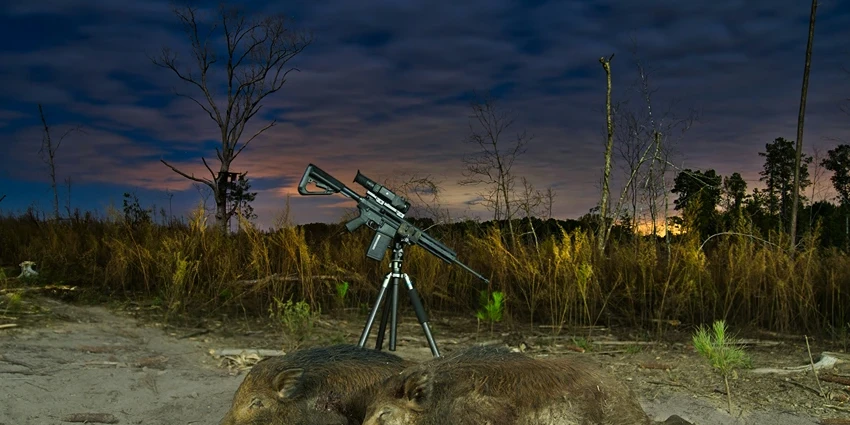Early morning hunting presents a unique set of challenges and opportunities for hunters. The quiet, pre-dawn hours can be one of the most rewarding times to hunt, but they require specific strategies and preparations. In this article, we delve into the world of early morning hunting, offering insights and tips to help you maximize your chances of success.
Jump to:
Preparation for Early Morning Hunts
Gear and Equipment Essentials
When preparing for an early morning hunt, choosing the right gear is vital. You’ll need clothing that can adapt to the changing temperatures of dawn, along with reliable navigation tools for moving in low light conditions. Opt for gear that enhances stealth, like noise-reducing clothing and scent control products.
Register for our latest in-depth reviews and product round-ups from the experts.
Enter your email address below to receive our monthly review emails.
By entering your details, you are agreeing to our terms and conditions and privacy policy. You can unsubscribe at any time.
Essential Gear for Early Morning Hunting
| Item | Purpose |
| Camouflage Clothing | Blends with the environment |
| Scent Control Products | Masks human scent |
| Noise-Reducing Gear | Minimizes sound while moving |
| Reliable Navigation Tools | Assists in low light conditions |
| Temperature-Adaptive Clothing | Adjusts to changing temperatures |
Scouting and Location Selection
Scouting is crucial for early morning hunting. For beginners, it’s important to understand the optimal hunting timing for beginners, which includes looking for signs of animal activity such as tracks, bedding areas, and feeding spots. Choose a location that allows you to move in and out without disturbing the wildlife. Consider wind direction and the path of the sun when selecting your spot.
Understanding Animal Behavior at Dawn
Movement Patterns of Common Game
Animals have distinct movement patterns at dawn. Deer, for example, may be returning to their bedding areas after a night of feeding. Understanding these patterns can help you position yourself effectively.
Impact of Light and Temperature
Light and temperature changes at dawn can influence animal behavior. Many species are more active during this time, making it an ideal hunting window. However, this also means you need to be extra cautious with your movements.
Stealth and Approach Techniques
Silent Movement Strategies
Moving silently is crucial in the early morning when sounds are amplified in the quiet environment. Practice walking quietly and avoid stepping on twigs or dry leaves. Use natural cover to conceal your movements.
Camouflage and Scent Control
Effective camouflage helps you blend into your surroundings, while scent control minimizes your presence. Use camouflage patterns suited to your hunting environment and apply scent control sprays to mask human odors.
Tips for Effective Camouflage and Scent Control
- Choose camouflage patterns that match the environment.
- Apply scent control sprays to clothing and gear.
- Avoid strong-smelling foods or products before the hunt.
Advanced Hunting Strategies
Using Calls and Decoys Effectively
Calls and decoys can be highly effective in early morning hunts, especially during the pre-rut period, which is a crucial time leading up to the hunting during rut season. Use grunt calls to mimic the sounds of bucks and doe bleats to attract attention. Decoys should be positioned strategically to lure game into your shooting range.
Effective Use of Calls and Decoys
| Call/Decoy Type | Purpose |
| Grunt Calls | Mimic buck sounds to attract rivals |
| Doe Bleats | Attract bucks looking for does |
| Decoy Placement | Visible but not threatening to game |
 Positioning and Ambush Tactics
Positioning and Ambush Tactics
Choosing the right position is crucial for a successful hunt. Look for natural funnels, edges of feeding areas, or trails leading to bedding areas. Ambush tactics involve patience and understanding the game’s movement patterns.
Key Positioning for Ambush
| Location | Advantage |
| Natural Funnels | Channel animal movements |
| Feeding Area Edges | Catch game during feeding times |
| Trails to Bedding Areas | Intercept game returning to rest |
Safety and Ethical Considerations
Navigating in Low Light Conditions
Navigating in the dark requires caution. Use a headlamp with a red light to preserve night vision and avoid spooking game. Always be aware of your surroundings and have a clear path to your hunting spot.
Ethical Hunting Practices
Ethical hunting involves respecting wildlife and the environment. This includes taking clean shots, following local hunting regulations, and practicing sustainable hunting methods.
FAQs on Early Morning Hunting
It’s advisable to start your hunt well before dawn, giving you enough time to reach your spot and settle in as the wildlife begins to stir.
Scent control is crucial. Game animals have a keen sense of smell, and minimizing human scent can significantly increase your chances of success.
Yes, weather conditions like wind direction, temperature, and humidity can affect animal behavior and movement, influencing your hunting strategy.
Tyler Bradford, the dynamic co-creator of Best Hunt Gear and a seasoned hunter, partners with Chester Jameson to elevate the platform. With his extensive knowledge of hunting techniques and gear, Tyler infuses innovative ideas and fresh perspectives. As Co-Chief Hunter, he enriches the hunting community with valuable insights and guidance for successful experiences in the wild.








